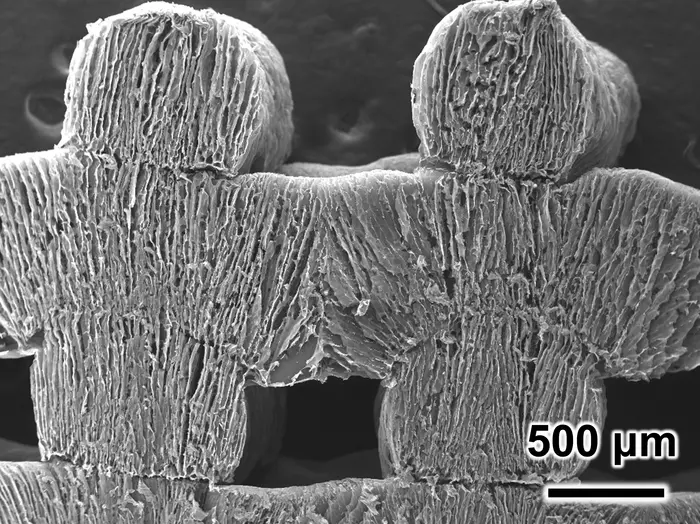In a groundbreaking advance poised to revolutionize the field of sustainable water treatment, researchers have engineered a novel 3D-printed aerogel capable of efficiently desalinating seawater using only sunlight. Published in the prestigious journal ACS Energy Letters, this innovative sponge-like material represents a significant stride toward overcoming the massive global challenge of freshwater scarcity without relying on energy-intensive infrastructure.
Earth’s oceans hold approximately 97% of the planet’s water, yet their high salinity renders this bounty undrinkable without treatment. Traditional desalination techniques, such as reverse osmosis and thermal distillation, require vast amounts of electricity or heat, making them costly and environmentally burdensome. Seeking a solution that harnesses renewable energy and offers scalability, scientists led by Xi Shen have developed an aerogel with distinctive microscopic structures that optimize solar vapor generation while maintaining consistent efficiency irrespective of size.
Unlike conventional hydrogels that rely on liquid-filled pores and tend to exhibit squishy, gel-like properties, this aerogel features a rigid architecture composed of solid pores. The researchers crafted a composite paste integrating carbon nanotubes alongside cellulose nanofibers, then employed an additive freeze-printing technique to meticulously deposit successive layers onto a frozen surface. This layered process yields a porous matrix riddled with uniform vertical channels approximately 20 micrometers wide, providing directional pathways for water vapor to escape during evaporation.
.adsslot_2MIKcpjvoF{ width:728px !important; height:90px !important; }
@media (max-width:1199px) { .adsslot_2MIKcpjvoF{ width:468px !important; height:60px !important; } }
@media (max-width:767px) { .adsslot_2MIKcpjvoF{ width:320px !important; height:50px !important; } }
ADVERTISEMENT
One of the formidable issues in scaling up solar-driven desalination materials is a decline in evaporation performance as the material’s size increases. However, the unique design of this aerogel overcomes this obstacle by maintaining size-insensitive vapor diffusion. Experiments using samples ranging from a mere one centimeter square to over eight centimeters confirmed that larger samples did not suffer diminished efficiency, an essential attribute for practical, real-world applications.
Outdoor field tests underscored the practical utility of this technology. After six hours under natural sunlight, the setup yielded approximately three tablespoons of clean water—an impressive proof-of-concept volume for a relatively compact device. The ability to operate entirely on ambient solar energy positions this aerogel as a promising candidate for off-grid desalination solutions, especially in remote or resource-limited regions.
Central to the aerogel’s performance is the synergistic role of its constituent materials. Carbon nanotubes contribute exceptional thermal conductivity, facilitating rapid heating of the evaporative surface, while cellulose nanofibers provide structural integrity alongside hydrophilic channels to draw seawater efficiently. The freeze-printing fabrication process enables precision control over pore size and distribution, a critical factor in optimizing vapor flow dynamics and evaporation rates.
This breakthrough resonates profoundly in the context of global water security. With climate change exacerbating droughts and freshwater scarcity, technologies that tap abundant solar energy for water purification hold immense promise. The scalability of the aerogel, combined with its energy-free operation and straightforward manufacturing techniques, could enable decentralized deployment, empowering communities worldwide to access clean drinking water sustainably.
Prior efforts to harness solar energy for desalination have leveraged hydrogels mimicking natural porous structures such as loofahs, which demonstrated rapid water vapor release upon sunlight exposure. Yet these hydrogels often suffer from mechanical fragility and size-dependent performance. Aerogels, with their solid pore networks, provide enhanced dimensional stability but traditionally face challenges with evaporation efficiency in larger formats. Addressing these limitations, the newly reported aerogel design exemplifies how advanced materials engineering can surmount longstanding barriers.
The research team envisions that future iterations may improve water yield through integrating photothermal coatings or coupling with passive condensation surfaces to maximize vapor capture. Moreover, the additive freeze-printing methodology lends itself to customization for various deployment scenarios, tailoring pore geometries and layer thicknesses to optimize performance under diverse climatic conditions.
In conclusion, the development of this size-insensitive, additive freeze-printed aerogel marks a pivotal advancement toward scalable, low-energy desalination. By translating solar energy directly into potable water without external power inputs, the technology aligns with global sustainability goals and offers a transformative approach to addressing one of humanity’s most pressing environmental challenges. As further studies explore optimization and deployment strategies, this solar-powered sponge may well become a cornerstone in the quest for accessible, clean water worldwide.
Subject of Research: Solar-driven, size-insensitive desalination using 3D-printed aerogels
Article Title: “Size-Insensitive Vapor Diffusion Enabled by Additive Freeze-Printed Aerogels for Scalable Desalination”
News Publication Date: July 2, 2025
Web References: http://pubs.acs.org/doi/abs/10.1021/acsenergylett.5c01233
References: Adapted from ACS Energy Letters 2025, DOI: 10.1021/acsenergylett.5c01233
Image Credits: Adapted from ACS Energy Letters 2025, DOI: 10.1021/acsenergylett.5c01233
Keywords
Chemistry, Water, Desalination, Aerogels, Solar Energy, Nanomaterials, Sustainable Technology
Tags: 3D-printed aerogel applicationsadvances in water desalination researchcarbon nanotubes in engineeringcellulose nanofibers in aerogelsefficient seawater desalination methodsfreshwater scarcity solutionsinnovative materials for water purificationovercoming global water crisisrenewable energy in desalinationsolar desalination technologysolar-powered water treatmentsustainable water treatment solutions





